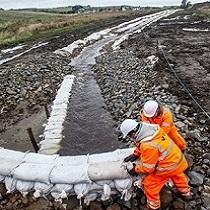 The longest new domestic railway to be constructed in Britain for over 100 years runs partly through the River Tweed Special Area of Conservation (SAC). Scottish Natural Heritage (SNH) requires an Appropriate Assessment for this part of the route.
The longest new domestic railway to be constructed in Britain for over 100 years runs partly through the River Tweed Special Area of Conservation (SAC). Scottish Natural Heritage (SNH) requires an Appropriate Assessment for this part of the route.
This £294m project, the Border Railway between Tweedbank and Edinburgh, included major engineering works and ran to a tight timetable. It also ran along the Gala Water, a tributary of the River Tweed and habitat for trout and salmon, as well as a number of other species. Extensive environmental assessment was essential.
Time for WHS
WHS needed to complete the aquatic aspects of the assessment and take a proactive role in mediating discussions between SNH and the consultant engineers. The main concern was whether the planned engineering work and the railway’s future operation would have an adverse impact on the integrity of the SAC.
We completed extensive field surveys along 16.5km of the Gala Water, assessing 49 engineering locations along the proposed route, including a river diversion, culverts, bridges and extensive bank strengthening works.
We reported on the potential construction impact and long-term impact of the scheme at each location. A number of engineering designs needed to be significantly altered to gain approval from SNH, so we discussed each location in detail with the engineers to find ways to adapt their proposals.
A key example was engineering ‘softening’ to reduce hard bank protection by over 90%, significantly lessening the environmental impact of the scheme and improving it aesthetically.
WHS was also called on to provide evidence to the Scottish Parliament in its review of what was the largest Appropriate Assessment in Europe at the time. We retained a role in the project’s environmental management team as it moved from planning to construction, including further assessment work.
Result: Scottish Natural Heritage approved the scheme, followed by Royal Assent in July 2006.
The new Borders Railway was officially opened by the Queen on schedule, on 9 September 2015, the day she became Britain’s longest-serving monarch. The stronger and more reliable transport connections are expected to boost employment, business, tourism and leisure in the area.